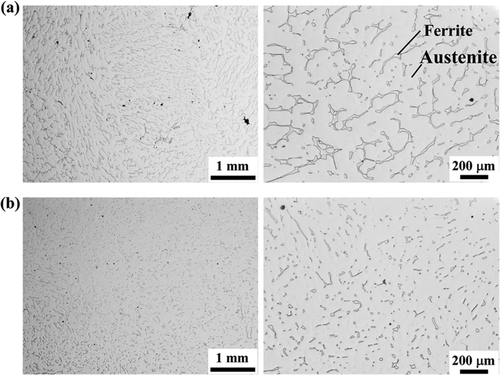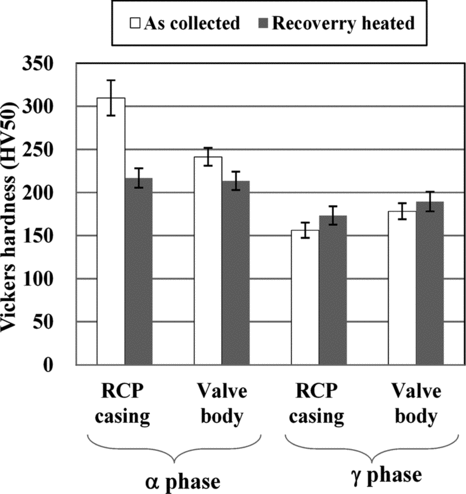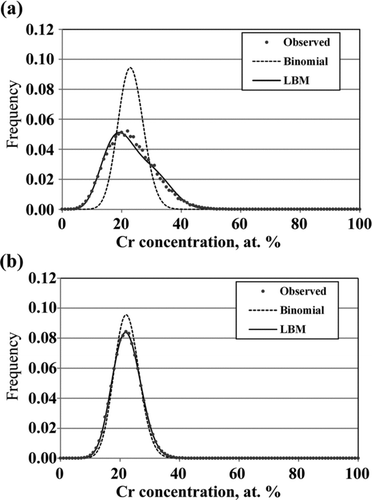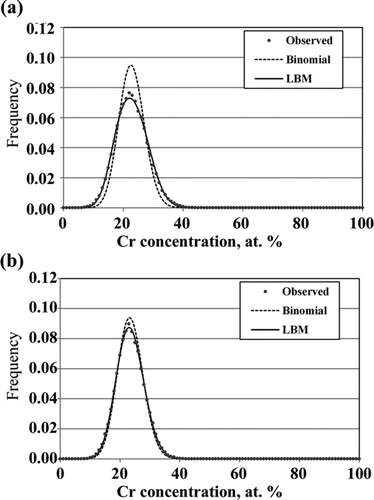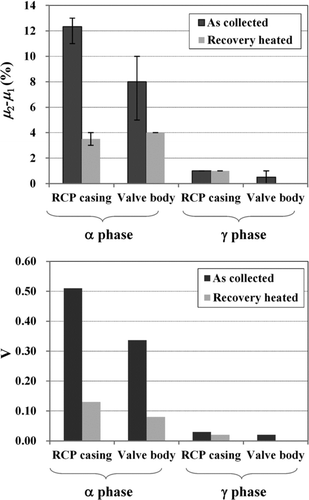Abstract
The influence of thermal aging on cast stainless steels used in JAEA's advanced thermal prototype reactor “Fugen” that were exposed to 275°C for about 15 years was investigated. The degree and mechanism of thermal embrittlement were evaluated on the basis of Charpy impact test results and the three-dimensional atom probe (3DAP) analysis of the microstructural changes in the spinodal decomposition using materials obtained from Fugen. The results revealed early signs of a thermal aging effect over a long period at the low temperature.
1. Introduction
Cast stainless steels are extensively used in light water reactors (LWR) for fabricating valve bodies, pump casings, and primary coolant piping. These materials are primarily austenitic, but contain a small proportion of ferrite (typically up to about 20%), which is added to improve the soundness of the casting, weldability, and resistance to stress corrosion cracking as well as to achieve the required strength. Previous studies [Citation1–Citation5] have shown that thermal aging between 300 and 500°C causes hardening and embrittlement of the ferrite phase, known as 475°C embrittlement. Embrittlement occurs when failure is dominated by brittle fractures associated with either the cleavage of ferrite or the separation of the ferrite/austenite phase boundaries. The microstructural evolution of the ferrite phase decomposes into two coherent phases via a spinodal decomposition: α (Fe rich) and α′ (Cr rich). This microstructural evolution is the primary strengthening mechanism that can raise the local tensile stress above the critical value for cleavage, thereby promoting brittle failures. In addition, the growth of phase boundary carbides and nitrides leads to brittle failures caused by phase boundary separation and also facilitates the cleavage of ferrite caused by particle cracking. The ability to predict the degree of toughness loss suffered during normal and extended reactor service life would be valuable when assessing the soundness of cast stainless steel reactor components. Therefore, models for predicting changes in the mechanical properties of cast stainless steel components due to thermal aging on the basis of an expanded database were established in previous studies [Citation6,Citation7]. However, to establish the toughness of the actual component in service in a reasonable time period, the aging process in the test material must be accelerated for the aging temperature range 300–400°C. Thus, to confirm the applicability of the knowledge obtained by these accelerated tests to the toughness of the actual component in service, it is very important to examine the thermal embrittlement mechanism using data obtained from materials that have aged as long as possible on site.
The advanced thermal reactor (ATR) Fugen is a prototype heavy water moderated, boiling light water cooled, pressure tube reactor that was shut down after 25 years of operation. A program for the decommissioning of Fugen was approved by a safety authority in 2008, and dismantling of the reactor is currently underway [Citation8]. Although Fugen is not an LWR, cast stainless steels were used for fabricating the recirculation pump (RCP) casings and valve bodies. These components were used at 275°C. Therefore, in this study [Citation9], the degree of toughness and the microstructural characterization of cast stainless steel components dismantled from Fugen were investigated to determine the thermal aging effect at the low temperatures.
2. Materials and experimental techniques
2.1. Materials
Samples from an RCP casing and an injection valve body, both of JIS SCS13 grade, used in Fugen, were procured. The RCP casing assembly was in service for ∼15 years (138,000 h) at 275°C. The injection valve body assembly was in service under 40°C. The temperature data were obtained by monitoring the value of the circulating water temperature. The range of temperature fluctuation in-service was less than 1°C. shows the chemical compositions of the samples in conjunction with the ferrite content, as calculated by ASTM A800 and measured using a ferrite scope (Fischer, MP30). The ferrite morphologies are shown in Figure . The mean ferrite spacing is in the range of 150–200 μm. However, unaged samples, such as castings were not stored, and therefore, the toughness and microstructure before and after thermal aging could not be compared. In an Fe–Cr alloy, the α′ phase is not stable at 550°C, and the alloy gets embrittled after aging for >10 h at 550°C owing to the formation of a sigma phase [Citation10,Citation11]. The loss of toughness in cast stainless steels can be recovered by annealing for a period of 1 h at 550°C followed by water quenching to dissolve the α′ phase and prevent the sigma phase from precipitating [Citation2,Citation12]. Therefore, to investigate the thermal aging effect on the Fugen materials, the mechanical properties and microstructure before and after the recovery heating (550°C × 1 h, water quenching) were compared. In this comparison, the microstructural characterization was performed with careful attention to any precipitates such as the G phase, carbides, and nitrides.
Table 1 Chemical composition and ferrite content of cast stainless steel samples from Fugen
2.2. Experimental techniques
2.2.1. Mechanical tests
Specimens for the Charpy impact tests were machined from the Fugen materials before and after the recovery heating was performed. The specimens had a cross section of 10 mm × 5 mm and a length of 55 mm. Notches 2 mm deep at a 45° angle and with a root radius of 0.25 mm were machined in the specimens. The Charpy impact test was performed at ambient temperature. Three specimens were used in each condition.
The aging behavior of ferrite and austenite was evaluated using the micro-Vickers hardness test. In this study, a load of 50 g was used, which gave an indentation size of the order of 20 μm. The indents were placed in selected large areas of ferrite that were typically at least 100 μm across. Ten measurements were made for each sample, and the results were averaged for subsequent analysis.
2.2.2. Microstructural characterization
Transmission electron microscopy (TEM) is very conventional and useful for the observation of such microstructures, because of the nanometer scale at which microstructural evolution takes place. However, in an Fe–Cr alloy, the combination of the similarity of the X-ray scattering factors of these elements and the coherency and complex morphology of the α and α′ phases as well as the scale of the phases, which are typically significantly smaller than the thickness of the sample, has limited the use of TEM for the characterization of the early stages of phase separation. On the other hand, an atom probe is a very effective instrument for studying phase separations of the several-nanometer scale, because it provides both atomic-scale microstructure and atomic-scale microchemical analysis of the observed phases.
The area analyzed by an atom probe is small, for example, tens of nanometers square by a few nanometers deep; therefore, it is rare for the interface between the α and γ phases to be included in this area. Thus, to obtain samples from specific locations in the microstructure and to separate the analyzed area into the α and γ phases, needle-like atom probe specimens were prepared with an FIB/SEM system (Hitachi nanoDUE’T® NB5000) by the lift-out method, as reported by Thompson et al. [Citation13]. A square rod was fabricated into a needle by annular ion milling using a 40 kV ion beam. The pre-sharpened specimen was polished to a sharp tip using a 5 kV ion beam in order to remove the damaged layer.
Three-dimensional atom probe (3DAP) analyses were performed using a local electrode atom probe with a reflectron (CAMECA LEAP 3000X HR®) facility [Citation14]. The atom probe specimens were electrically pulsed with a pulse fraction of 15% and a pulse repetition rate of 200 kHz. The analyses were performed under an ultrahigh vacuum of greater than 1 × 10−8 Pa at a specimen temperature of 60 K. Only data-sets with more than 3.0 million atoms were used to ensure that the reconstructed volume of the material was sufficient to characterize the phase separation. The mass resolution (m/Δm) was more than 500 full widths at half maximum. Fe, Cr, Ni, Si, S, P, C, and Mn atoms were detected as Fe2+ = 27.0, 28.0, 28.5; Cr2+ = 25.0, 26.0, 26.5; Ni2+ = 29.0, 30.0, 30.5, 31.0; Si2+ = 14.0, 14.5, 15.0; S2+ = 15.5, 16.0, 17.0; P3+ = 10.3; C+ = 12.0; C2+ = 6.0; and Mn2+ = 27.5, all of which were well separated.
The amplitude of the chromium concentration fluctuation was estimated by the variation method [Citation15] and the Langer—Baron–Miller (LBM) method [Citation16]. Previous studies on phase separation have used a statistical analysis of the concentration frequency distribution [Citation17]. A frequency distribution is obtained by dividing the three-dimensional volume of atoms into equal-sized blocks, estimating the composition of each block, and plotting the observed number of blocks in each composition. A random solid solution will conform to a binominal distribution. In the variation method, the parameter V is defined as the difference between the observed experimental frequency distribution, P(n), and the binominal distribution, B(n), calculated with the same mean concentration as follows:
3. Results
3.1. Mechanical tests
A comparison of the Charpy impact energy before and after the recovery heating is shown in Figure . An increase in the Charpy impact energy was observed for the specimen from the RCP casing after the recovery heating, but there was no measurable change in the impact energy for the valve body operated under 40°C. A comparison of the micro-Vickers hardness of the ferrite and austenite phases before and after the recovery heating is shown in Figure . There were no significant changes in the hardness of the austenite phase. On the other hand, the hardness of the ferrite phase in the specimen decreased after the recovery heating, and this tendency was more evident in the specimen from the RCP casing than that from the valve body component.
3.2. Microstructural characterization
Table shows the chemical composition of the ferrite and austenite phases obtained by performing the 3DAP analysis. There was no difference between the component samples in terms of chemical composition. In addition, no change in the chemical composition of the samples was observed after the recovery heating, and there was no difference in the ferrite content before and after the recovery heating: 12.0 ± 2.7% and 12.4 ± 4.0%, respectively, for the RCP casing and 6.7 ± 1.9% and 6.9 ± 4.0%, respectively, for the valve body.
Table 2 Chemical composition of cast stainless steels as measured by 3DAP
The chromium concentration distribution maps for the ferrite phase of the RCP casing and the valve body specimens obtained via 3DAP measurement are shown in Figures and , respectively. The amplitude of the chromium fluctuation of the RCP casing sample decreased after the recovery heating, as shown in Figure ; however, no particular change in amplitude was observed for the valve body, as shown in Figure . The Ni and Si atoms were distributed homogeneously, and neither precipitates nor clusters composed of these atoms were observed in either component. Figure shows a bright-field scanning transmission electron microscopy (BF-STEM) image of the RCP casing as collected. Precipitates, such as the G phase, carbide, and nitride were not observed in the matrix.
Figure 4 Chromium concentration distribution in α phase of a recirculation pump casing obtained using 3DAP: (a) as collected and (b) as recovery heated
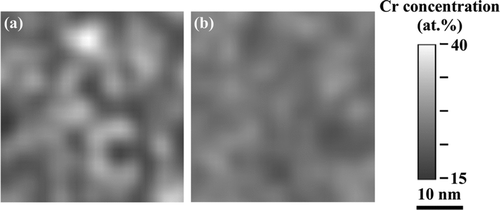
Figure 5 Chromium concentration distribution in α phase of an injection valve body obtained using 3DAP: (a) as collected and (b) as recovery heated
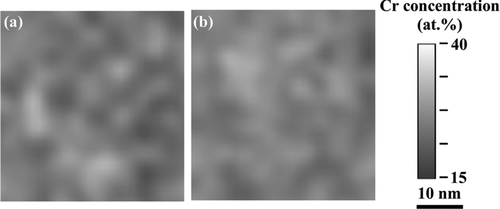
Figure 6 BF-STEM images of a recirculation pump casing as collected; (a): austenite phase, (b): ferrite phase
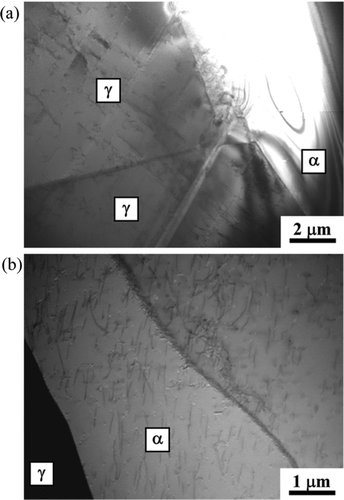
Figures and show the chromium concentration profiles obtained from the 3DAP analysis of the RCP casing and the valve body, respectively. In the figures, after the recovery heating, a comparison of the observed experimental frequency distribution with the binominal distribution, as expected for a random solid solution, indicated good agreement in both the RCP casing and the valve body. These results indicate that the α′ phase was dissolved and the chromium atoms were distributed homogeneously. On the other hand, for the RCP casing before the recovery heating (as collected), the experimental frequency distribution broadened and decreased in amplitude as compared with the binominal distribution. This result indicated that phase separation decomposition had occurred owing to thermal aging at the low temperature. As shown in Figure (a), the frequency distribution for the valve body before recovery heating shows the same tendency as that for the RCP casing, but to a lesser extent. LBM models fitted to the experimental distributions are also included in Figures and . As reported in previous studies [Citation18], the LBM model does not provide a good fit over a longer aging period. However, in this study, the phase separation decomposition state of the samples as collected is in an early stage; hence, the LBM fits are in good agreement with the plots of the experimental data.
4. Discussion
Previous studies [Citation3–Citation5,Citation11] found that changes in the Charpy impact energy have a significant correlation with the hardening in the ferrite phase as a result of thermal aging. The results in this study are in agreement with these previous findings. However, apart from the hardness of the ferrite phase in the valve body specimen slightly decreasing after recovery heated, there was no change in the impact energy. This difference in the sensitivity of the impact energy to the change in hardness is attributable to the difference in the ferrite content of each component. In general, the sensitivity of the impact energy increases with the ferrite content. The ferrite content of the valve body (approximately 5%) was less than that of the RCP casing (approximately 13%), and thus, there was no change in the impact energy of the specimen from the valve body.
The degree of the microstructural change due to spinodal decomposition was evaluated quantitatively. Figure shows a comparison of the amplitude of the chromium concentration fluctuation before and after the recovery heating. The results obtained using the variation method and the LBM method show the same tendency, and the amplitude of the chromium concentration of the samples as collected is higher than that of the recovery heated samples. The changing trends in the amplitude of the chromium concentration fluctuation due to phase separation and that of hardness are closely associated with the increase in hardness accompanying the amplitude of the concentration fluctuation resulting from the elastic strain and the misfit effect, as reported by Auger et al. [Citation18]. As shown in Figures and , the results obtained in this study are in good agreement with those of previous studies.
The recovery-heated samples were used for comparison in order to investigate the thermal aging effect. This recovery heating can dissolve the α′ phase; however, precipitates such as the G phase do not dissolve [Citation2,Citation5]. Precipitates such as the G phase, carbide, and nitride in the ferrite and austenite phases in the RCP casing and the valve body were not observed by STEM. Therefore, the changes in hardness after thermal aging and after the recovery heating, as shown in Figure , were principally caused by the precipitation and dissolution of only the α′ phase in the samples. The precipitation of chromium-rich carbides is always accompanied by a decrease in the ferrite content [Citation2,Citation19]. The depletion of chromium destabilizes the ferrite phase, leading to a ferrite-to-austenite transformation along the phase boundary. These phase boundary carbides are important parameters in controlling the fracture mode of cast stainless steels because the carbides weaken the boundaries and lead to phase boundary separation, which is an additional low-toughness fracture mode. In addition, they also initiate the cleavage of ferrite at lower stress levels due to carbide cracking. In this study, there were no differences in the ferrite content and chemical composition in the phases before and after the recovery heating. Thus, during the recovery heating, the carbides did not precipitate. The changes in the Charpy energy after the recovery heating (Figure ) were principally caused by the hardening that resulted from the precipitation and dissolution of only the α′ phase in the ferrite phase. However, the mechanisms of embrittlement of cast duplex stainless steel is caused by brittle fracture associated with either the cleavage of the ferrite or the separation of the ferrite/austenite phase boundaries, as reported by previous studies [Citation2,Citation3]. For a detailed discussion of the embrittlement mechanisms of Fugen served materials, it is necessary to take into account the influence of precipitation of phase boundary carbides during the production heat treatment and morphology of the ferrite phase, in future work.
In the valve body sample as collected, the chromium modulation structure due to the phase separation had an effect on the hardness, as shown in Figures and . Because the injection valve body assembly was in service under 40°C, it seems that the phase separation progressed, not during plant operations but during production heat treatment of the casting, and was dependent on the cooling rate. Unaged samples, as castings, were not available for this study; therefore, it is difficult to obtain the knowledge of the microstructure prior to the operation. However, as is well known, the mechanical properties of stainless steels depend on the casting conditions [Citation2] partly because of the progression of the phase separation during the production heat treatment as a function of the cooling rate.
5. Conclusion
This study focused on the phase separation in the ferrite phase for cast stainless steels used in the ATR Fugen and through Charpy impact tests and microstructural characterization using 3DAP analysis revealed early signs of a thermal aging effect over a long period at low temperature (275°C). Microstructural characterization using 3DAP analysis indicated that the phase separation had progressed during long-term aging on site. In addition, the results of the Charpy impact tests indicated a decrease in the fracture toughness, but to a lesser extent. Although, the degree of this decrease in the fracture toughness is very small, it is important to investigate the mechanism of thermal aging embrittlement using the Fugen materials in order to predict the degree of loss of toughness during a reactor service life. It seems that the degree of decrease in fracture toughness resulting from thermal aging is dependent on not only the progression of the phase separation but also the interface strength. Investigating the influence of precipitation (carbide and nitride) and the coherency on the interface strength of the α–γ interface is a subject for a future study.
Acknowledgements
This research was sponsored by the Japan Nuclear Energy Safety Organization (JNES). Useful discussions with members of the JNES are much appreciated. Dr. Tsunemitsu Yoshitake and Dr. Ryuichiro Ogawa of Oarai Research and Development Center, Japan Atomic Energy Agency, provided excellent technical support in performing the experiments.
References
- Trautwein , A and Gysel , W . 1982 . Influence of long-time aging of CF8 and CF8M cast steel at temperatures between 300 and 500°C on impact toughness and structural properties in stainless steel castings . ASTM STP , 756 : 165 – 189 .
- Chopra , O K . 1990 . Initial assessment of the mechanisms and significance of low-temperature embrittlement of cast stainless steels in LWR system , U.S: Nuclear Regulatory Commission . NUREG/CR-5385, ANL-89/17
- Bonnet , S , Bourgoin , J , Champredonde , J , Guttmann , D and Guttmann , M . 1990 . Relationship between evolution of mechanical properties of various cast duplex stainless steels and metallurgical and aging parameters: outline of current EDF programmers . Mate Sci Technol , 6 : 221 – 229 .
- Pumphrey , P H and Akhurst , K N . 1990 . Aging kinetics of CF3 cast stainless steel in temperature range 300–400°C . Mate Sci Technol , 6 : 211 – 219 .
- Yamada , T , Okano , S and Kuwano , H . 2006 . Mechanical property and microstructural change by thermal aging of SCS14A cast duplex stainless steel . J Nucl Mater , 350 : 47 – 55 .
- Chopra , O K . 1994 . Estimation of fracture toughness of cast stainless steels during thermal aging in LWR systems , U.S: Nuclear Regulatory Commission . NUREG/CR-4513, ANL-93/22
- Kawaguchi , S , Nagasaki , T and Koyama , K . 2005 . Prediction method of tensile properties and fracture toughness of thermally aged cast duplex stainless steel piping . Proceedings of PVP2005 ASME Pressure Vessels and Piping Division Conference . July 17–21 2005 , Denver , Colorado , USA.
- Morishita , Y . 2008 . Basic policy for decommissioning of nuclear power plant in Japan and the decommissioning Fugen . Proceedings of International Symposium on Advanced Mechanical and Power Engineering; 2008 . Oct. 9–12 2008 , Busan , Korea. pp. 211 – 217 . ISAMPE 2008
- Japan Nuclear Energy Safety Organization . 2011 . Study of aging management in Fukui prefecture , Japan Nuclear Energy Safety Organization . [in Japanese]
- Chung , H M and Chopra , O K . 1989 . Kinetics and mechanism of thermal aging embrittlement of duplex stainless steels . Proceedings International Workshop on Intermediate-Temperature Embrittlement Process in Duplex Stainless Steels . Aug. 1–2 1989 , Oxford , England. pp. 359 – 370 .
- Vitek , J M , David , S A , Alexander , D J , Keiser , J R and Nanstad , R K . 1991 . Low temperature aging behavior of type 308 stainless steel weld metal . Acta Metall Mater , 39 : 503 – 516 .
- Li , S L , Zhang , H L , Wang , Y L , Li , S X , Zheng , K , Xue , F and Wang , X T . 2012 . Annealing induced recovery of long-term thermal aging embrittlement in a duplex stainless steel . Mater Sci Eng A , 564 : 85 – 91 .
- Kelly , T F , Larson , D J , Thompson , K , Alvis , R L , Bunton , J H , Olson , J D and Gorman , B P . 2007 . Atom Probe Tomography of Electronic Materials . Annu Rev Mater Res , 37 : 681
- Kelly , T F , Gribb , T T , Olson , J D , Martens , R L , Shepard , J D , Wiener , S A , Kunicki , T C , Ulfig , R M , Lenz , D R , Strennen , E M , Oltman , E, , Bunton , J H and Strait , D R . 2004 . First data from a commercial local electrode atom probe (LEAP) . Microsc Microanal , 10 : 373 – 383 .
- Blavette , D , Grancher , G and Bostel , A . 2000 . Statistical analysis of atom-probe data (I): derivation of some fine-scale features from frequency distributions for finely dispersed system . J Phys , t49 : 433 – 438 . Colloque C6-11
- Hetherington , M G , Hyde , J M , Miller , M K and Smith , G DW . 1991 . Measurement of the amplitude of a spinodal . Surf Sci , 246 : 304 – 314 .
- Miller , M . 2000 . Atom probe tomography , New York : Kluwer Academic/Plenum Publishers .
- Danoix , F and Auger , P . 2000 . Atom probe studies of the Fe–Cr system and stainless steels aged at intermediate temperature: a review . Mater. Charact , 44 : 177 – 201 .
- Solomon , H D and Devine , T M Jr. 1983 . “ Duplex stainless steels–a tale of two phases ” . In Duplex stainless steels , Edited by: Lula , R A . 693 – 756 . ASM Metals Park .
